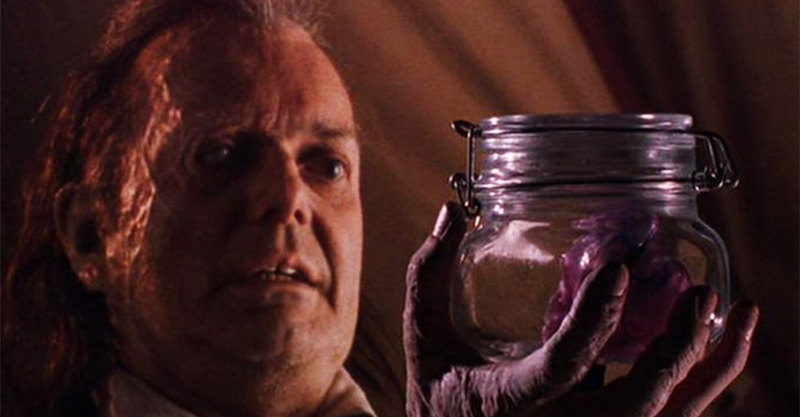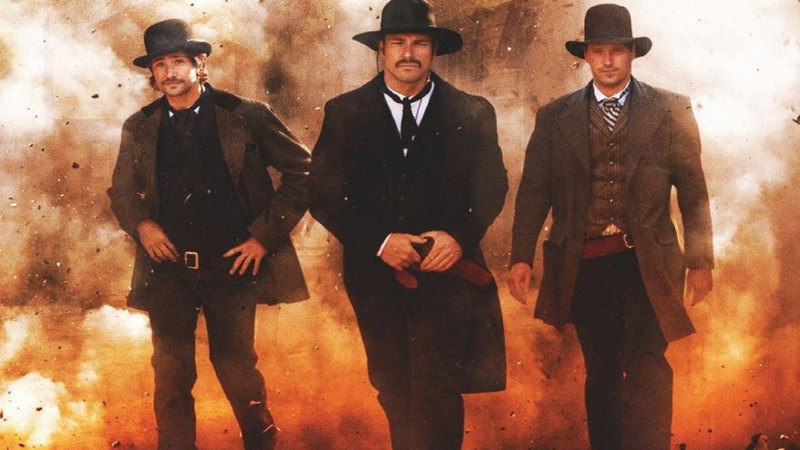Art is often used as a vehicle in film to mock human nature. It can be done subtly or in an over the top manner that satirizes the lengths that some go to to preserve their artistic mojo. Boris Rodriguez’s black comedy “Eddie The Sleepwalking Cannibal” uses art as it’s driving force to create some darkly satirical moments at this very premise.
Lars (Thure Lindhardt) is a once famous Danish painter who has a new teaching job at the Koda art school in small Canada. He has lost all creative inspiration and hopes that some time in relative solitude can bring it back. As he is driving into town he hits a deer and has to mercy kill it by beating it with a rock. Shortly after he is at the school speaking with the administrator who happened to be smitten with the fact that a famous artist has come to their sleepy little town. Lars is introduced to an eccentric mute fellow, Eddie (Dylan Scott Thomas) who likes to sit in on art classes even though he is not enrolled in the school. His rich aunt has been very generous with her money in giving to the school on a regular basis. The day after Lars arrives she dies and her large mute nephew Eddie is in need of a care taker. The school admin ask Lars and he agrees to it with only a little bit of reluctance. That first night, Lars notices Eddie’s propensity to homicidal sleepwalking as he is found standing bloodied outside in his underwear with a decapitated rabbit nearby. This apparently is described as a trauma induced behavior that has been triggered by his aunt’s death. This had happened before in the past after Eddie’s parents were killed but with less destructive results. What we find out is that Lars has a dark side in which he believes propels the genius in his art. Apparently experiencing scenes of gore and violence is his muse which helps him paint beautifully. Feeling the desperation of not being able to paint like he used to Lars taps into his dark side by using Eddie’s intense sleeping habits in hopes of reclaiming his status back in the art world. What ensues is a great deal of bloodiness involving much of the townsfolk.
Things move fast in “Eddie”. Plots devices and motivations seem to be a little too convenient in order to keep the story progressing the way it needs to go. Characters hardly have time to stop and think. Everyone Lars meets tends to be an asshole which makes it convenient for Lars to justify killing them for his muse. The film is a scant 83 minutes which hardly leaves any room for characters to contemplate leaving the experience a bit hollow and undeveloped. As for the style of the film, the widescreen cinematography is the biggest standout. Not so much for grandiosity but more for giving it a more polished and professional look.
The other standout aspect of the production is the horror soundtrack used. When the gruesome moments occur there is a terrific horror sounding score that accompanies it and it fits perfectly. This helps the film delve into the horror genre greatly. There are also moments when classical music is playing during some of the action as well which helps create a nice juxtaposition of class and brutality. Several times when Lars is listening to the classical radio station the DJ will go on to talk about composer’s gloomy inspirations for their music, giving a sense that beautiful art has always had a dark history.
This film mainly satirizes the ups and downs of the creativity process of an artist, where inspiration comes from and how to tap into it. There are discussions in the film about using heart and love or darkness and despair to fuel art. From this comes the idea of natural flowing talent versus needing a muse to stimulate creativity. The art that is produced in the film is never shown. Lars is only shown painting from the canvas’s point of view or from behind obscuring the view. As Lars has found his muse in Eddie, Co-worker Lesley (Georgina Reilly) has found her muse in Lars. She shows him her sculpture and as he looks at it and critiques it, it is filmed so you never see the entire piece. Either the creators did not want to claim what actual beautiful art is or they did not want to make the movie about the art but making it more about the process of making art.
Video:
AVC encoded 1080p transfer in 2.35:1. Outside scenes in the daylight show some terrific clarity and depth while contrast holds up nicely against the whiteness of the snow. Nighttime scenes, while still great looking, tend to become a little dim. This could be due to the slightly muted color palette used. Overall it is a satisying high definition image.
Audio:
DTS-HD Master Audio 5.1 is impressive most when the aforementioned mood music starts up as it hits a multitude of ranges from low rolling bass to high pitched moments of chaos aka screaming. The track never becomes tinny or muffled during these times. Range is not overly impressive as the surrounds are not heavily used but it does sound accurate.
Extras:
Making of: A 15 minute look into cast and crew talking about their experiences working on the film. I was surprised about the temperatures they filmed in, a said -20 below. There is also a Theatrical trailer included. Lastly is a 15 minute Short Film by Rodriguez entitled “Perfect“, which is an interesting (and dark) look at suburban life. This is in standard definition.
Bottom line:
Looked at as a satire, “Eddie” is a grim, comedic glance into an artist doing whatever it takes to get his creative mojo back. Plot advances are minimalist and convenient making the experience more of a roller coaster ride not to be taken too seriously. If viewed with that in mind, it becomes an entertaining exercise which blends moments from the horror genre with dramatic comedy. Even though it is an interesting idea executed with serviceable talent, it still comes off as being too breezy, convenient and short. Recommended to horror lovers looking for something a little new and up and coming wannabe filmmakers.


